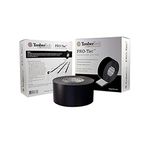Fastening and Decking Tools
Make sure you have these essential tools for fastening framing and putting down deck planks.

Fastening Tools
The galvanized nails of yore were great. They were inexpensive, quick to install, and held like crazy. Therein was their downfall. Make a mistake and have to redo something, and you quickly discovered just how tenacious that rough zinc coating was. You have to make a royal mess out of a board to remove it.
Screw fasteners hold even better than galvanized nails but can be backed out in moments if you make a mistake. The only current drawback is that manufacturers can’t seem to decide what style head they want to settle on—Phillips, hex, square, or star. That argues for a drill/driver with a quick-change chuck. Many fasteners are self-drilling, though even with those you want to drill a pilot hole if you are close to the edge of a board.
TIP: If you have to drill pilot holes for a fastener, do so with a second drill to avoid constantly changing out bits.
|
|
|
|
|
|
|
|
|
Corded drills only make sense if you are impact-drilling concrete. Otherwise, cordless drills are the way to go. Brushless types have a substantially longer run time between charges.
Small but Mighty
Pros swear by impact drivers for installing heavy-duty lag screws in deck framing. They are quick, powerful, and have plenty of battery power to see you through to a lunchtime charge-up. Speed and power come at a cost, however. The 20-volt models can cost up to $150—twice as much with batteries. Pneumatic types are also available.
TIP: If you purchase a pneumatic nailer, consider adding this handy hanger. It keeps close at hand a tool you just can’t fit into a tool belt.
Decking Tools
You can get away with installing the decking with the tools used for framing, but there are some optional items that will make the job easier. Careful technique with a circular saw enables you to cut all the decking to length, although a good chopsaw, set to the right height, will save your back and likely produce better results. To avoid splitting the decking or breaking screws, be sure to drill pilot holes 1. You can save some time by using two drivers instead of changing the bit each time you need to switch between driving and drilling 2.
Cut ends need to be rounded, and for softwoods a rough rasp does the trick with a few swipes. For hardwood, however, a trim router fitted with a 1/4-in. roundover bit is much faster than a rasp 3. Note that some fastening systems, such as Kreg’s, require proprietary tools 4. Other tools that come in handy are pipe clamps and a small prybar to move boards into alignment and a jigsaw for fitting decking around posts and door thresholds 5.
Three Tools for Prying Decks
Using a cat’s paw and a small block of wood is a simple and quick technique for minor decking adjustments. Protect the decking’s edge with the wood block, pound the cat’s paw into the joist, and pry the decking into place.

A wood wedge has a sharp metal U that bites into the joist as it is pounded down. The wedge works well, but varying lumber thicknesses can be a problem.

While it looks more medieval than modern, this cam-system adjuster is surprisingly efficient but carries a hefty price tag.

Fine Homebuilding Recommended Products
Fine Homebuilding receives a commission for items purchased through links on this site, including Amazon Associates and other affiliate advertising programs.

Angel Guard Deck Demon

Heat-Shrink Tubing

Flashing and Joist Tape

















